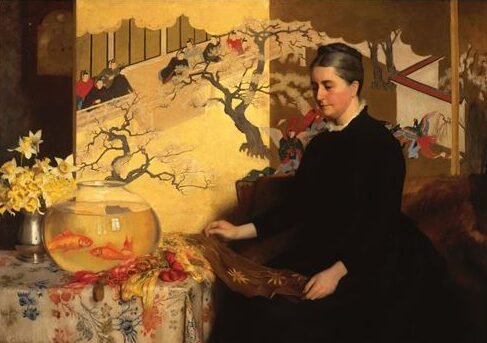A Short History of Aquariums: Scientific Curiosity, Aesthethic Delight and Conviviality
Global Convivial Forum
Ana Carolina Torquato (Junior Fellow Mecila)
Lady with a Japanese Screen and Goldfish, James Cadenhead (1858–1927).
In my research year as a Junior Postdoctoral fellow at Mecila, I have been dealing with the subject of animal captivity as means of entertainment. I am primarily interested in the representation of such establishments as zoos and aquariums in literature to understand better what kinds of thoughts, impressions, feelings, or questionings these “face-to-face moments” arise in the stories I delved into.
In the contemporary world, it is very common to find zoological gardens and aquariums in basically every big city around the globe. Their purpose as institutions which promote human/animal contact as their basic means for entertainment has not changed much since their early formats. However, although zoos and aquariums have similar characteristics, their history is different in situation and time. Whereas zoological gardens date back to earlier forms of private (and royal) animal collections, to menageries, to finally having the layout they have now – a place which displays animals, mostly terrestrial ones, to a wide public – aquariums have a more recent and somewhat multipurposed appearance in history.
A Brief History of the Aquariums
Human beings have a long tradition of keeping fish and other aquatic animals in the surroundings of the home. Naturally, the purpose behind such practice has changed significantly over time. There are signs of humans keeping fish at home as a food supply and an ornament to beautify their living spaces and gardens (Vernon 2001). In my research, I am particularly interested in the latter form of fish keeping, for they show us light into the history of aquariums as objects of aesthetic observation.

Although these species seem to have lost part of their ancient charm in contemporary times, one of the most beloved species in the history of fish keeping for ornamental purposes was the goldfish (Brunner 2005). These golden beings may be one of the kick-starters of a tradition that would become a fever in places like China, Japan, and some European countries.
While raising fish in water gardens has been a tradition in many places around the world, the modern idea of domestic conviviality between humans and aquatic animals was first popularized in the mid-nineteenth century with the creation of the at-home aquariums. Since then, the popularity of home aquariums grew fast and gave room to a genuine Age of aquariums: a time when educational interests, aesthetic curiosities, and the domesticity of unconventional pets revolved around one object.
The history of aquariums as we know them today starts with the creation of home aquariums. Such history was shaped by the collective work of many intellectuals and natural historians worldwide. Among these, two of the most frequently mentioned names belonged to two women: Anna Thynne (England, 1806–1866) and Jeanne Villepreux-Power (France, 1794 –1871).

Jeanne Villepreux-Power street in Paris is located in the vicinity of the Parc Zoologique Bois de Vincennes, a true Victorian aquarium kept at the Horniman Museum’s aquarium in London. (Personal archive.)
A true Victorian aquarium kept at the Horniman Museum’s aquarium in London. (Personal Archive.)

